Hisense RS696N4II1 Fridge-Freezer Review
Hisense RS696N4II1 Fridge-Freezer
Performance and build quality that belies its affordable price
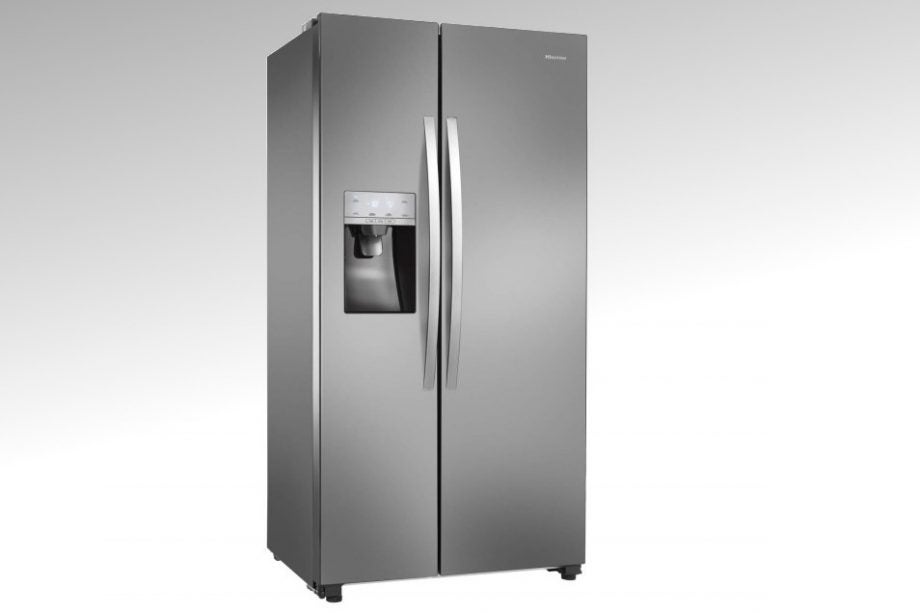
Verdict
Pros
- Excellent value
- Impressive build and design
- Solid cooling performance
- Enormous door pockets
- Good ice maker
Cons
- Fridge runs 2ºC too cool
- Shelves not adjustable
Key Specifications
- A+ energy rating
- 367-litre fridge capacity
- 168-litre freezer capacity
- Plumbed ice and water
- Stainless steel-look finish
- Electronic touch controls
- 910mm x 1786mm x 743mm (WHD)
- 2-year guarantee
What is the Hisense RS696N4II1?
Hisense has a habit of upsetting the apple-cart with great-looking, extremely well-specified domestic appliances at budget prices. Enter the RS696N4II1 fully featured side-by-side fridge freezer with ice/water dispenser and stainless-steel finish. Yours for less than £800.
While its temperature performance isn’t quite up to ultra-premium model standards, this Hisense cools consistently even though our fridge temperature was a little low. The ice and water dispenser work well and it looks great too. Running costs live up to its A+ rating and we were impressed with the quality of the fixtures and fittings. Bit of a bargain? We think so.
Related: Best fridge freezers
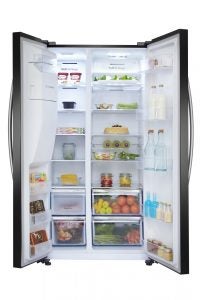
Hisense RS696N4II1 – How does it look?
Available in black or the sumptuous stainless-steel look we have on test, the Hisense RS696N4II1 is a bit of a looker. The stainless finish, brushed stainless handles and neat touch control panel make it look every bit the premium machine. Add in the plumbed in ice and water dispenser on the door and this model wouldn’t look out of place with a four-figure price ticket.
If you get a little closer then some cost savings become apparent, but they’re far from obvious. The stainless steel finish is actually a coated stainless ‘look’. That’s probably an advantage over pure stainless steel for homes with mucky family members – Hisense’s finish is near-immune to fingerprints. If you step back, you can see that the metal-work of the door isn’t quite as mirror-flat as a quality stainless steel panel. You do have to catch it in the right light to notice, though.
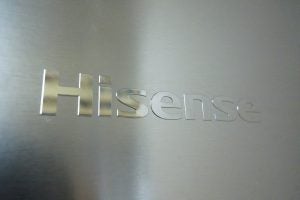
The handles are lush. Large, easy to grab, solid-feeling, immaculately fitted and finished. The same is true of the display and dispenser area. It’s clean, crisp and well-coordinated with the overall look.
This model is fully plumbed in with a long-life filter and hoses included in the pack. An indicator on the display flashes when the filter needs replacing. That should be around six months, or when it’s dispensed around 4500litres worth of water and ice. You have a choice of cubed or crushed ice, although the latter is a little noisy and spitty from the dispenser.
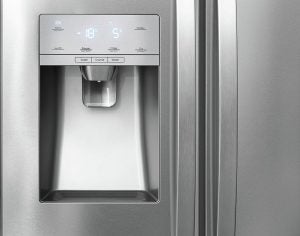
Swing open the doors and the Hisense continues to impress. Crisp white LED lighting in both sides is good, although a little restricted by the top-mount location. If you have a lot of stuff on the top shelf of the fridge in particular, the bottom half can suffer from shadows.
The symmetrical layout of five shelves and two drawers on each side looks great. None of the shelves are height-adjustable, however. Additional space for taller items will mean evicting a shelf completely. That won’t be a problem in the fridge, since the five-door pockets have plenty of headroom. The top three are ample deep enough for 2-litre milk bottles stored side-on.
Like all US-style in-door ice/water machines, freezer space takes a bit of a hit due to the ice maker. The mechanism and ice-bucket mean the top three shelves are truncated front to back. Thankfully, this Hisense counters with two good-sized drawers and a trio of unusually capacious door pockets.
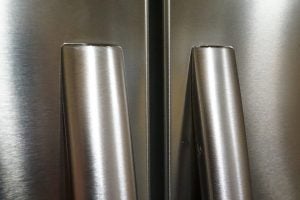
While there are no special drawers or fancily named storage areas, there’s still plenty of cutting-edge refrigeration tech at work here. This model has Hisense’s premium Multi Air Flow cooling system to ensure even temperatures throughout both compartments and completely frost-free operation. The Nano Fresh system aims to control humidity for greater fresh food longevity. Around the back, you get a modern long-life inverter motor.
From the glass shelves to the door pockets and drawers to the wine bottle rack, the build quality on show here is impressive for the money. Detailing is great, too, with every drawer running smoothly on proper rollers rather than cheap plastic sliders. Once again, Hisense has blown us away with superb features, great quality and sophisticated style for a very appealing price.
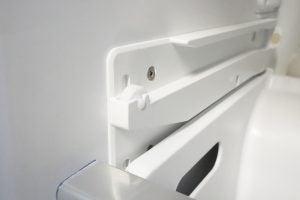
Hisense RS696N4II1 – How much can you fit in?
This Hisense’s overall dimensions are bang-on the standard size for a US-style fridge freezer at approximately 91cm wide, 75cm deep and just below 180cm tall. Wall thickness and areas taken up by the mechanicals do rob you of a little space. The net result is 367 litres of chiller space and 168 litres in the freezer.
There are competitor models with similar external dimensions but up to 10-15% more usable internal space. These models use ultra-high-tech insulation to keep the walls much thinner, but they do come at a premium. Up to twice the price of the RS696N4II1, in fact.
The fridge door pockets are all good. The mid pair easily cope with a large family’s worth of milk bottles and orange cartons, with plenty of room to manoeuvre. They were ample deep enough to avoid bottles toppling out with vigorous door opening too.

We struggled a little with the five shelves plus wine rack combination, as the positions are all fixed. After some real-world testing, we simply ended up removing the wine rack and moving the Pinot Grigio to the lower door pocket. Both drawers are capacious and roll out with ease.
Over in the freezer, the truncated upper shelves did result in our usual struggle with longer items such as a frozen Apple Strudel. While the box would fit on a diagonal, this isn’t a very efficient use of space. Thankfully, there was more room on the lower shelves and in the upper of the two drawers. Unusually, these drawers don’t extend to the very front of the cabinet, but rather stop short to allow room for the particularly large door pockets.
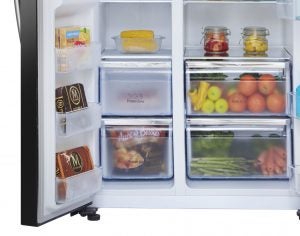
Whether this smaller drawer/larger door pockets combo is better or worse than big drawers and smaller or no door pockets is a personal preference. The Stevenson Jury was divided. Since the door pockets were big enough to freeze cycling water bottles for hot summer rides, they get my vote.
Again, none of the furniture is adjustable in the freezer. So if you need to store really large items you’re going to have to remove a shelf completely.
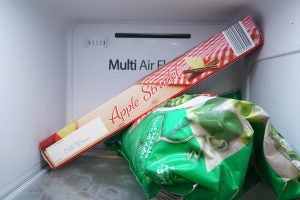
Hisense RS696N4II1 – How noisy is it?
Despite boasting a modern inverter motor, the Hisense doesn’t market itself as a really quiet runner. The energy label would have us believe a running noise of 42dB. That’s still fairly quiet, albeit at the upper end of noise from modern high-tech fridge freezers.
In our tests the Hisense rarely exceeded 40dB, which is much more in keeping with its inverter motor and build quality. Again, there are quieter US-style appliances available if you have deep pockets – but only by a couple of decibels.
As ever, the ice-maker gate-crashes the peaceful party when it dumps each tray of ice into its bucket storage. It doesn’t happen very often and stops when the bucket is full, however. If you further select Hisense’s ‘crushed ice’ setting, you can expect grinding and crunching sounds to match an industrial rock-crusher.
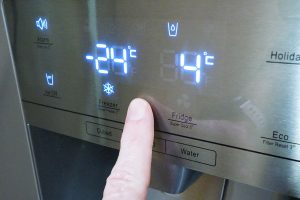
Hisense RS696N4II1 – How well does it perform?
We loaded up the RS696N4II1 up with 18.4kg (0.5kg/10-litre claimed net capacity) of fresh food, bottles and jars in the fridge and 16.8kg (1.0kg/10-litre capacity) in the freezer. The freezer quantity included 2 litres of room temperature water. This had a probe at its centre to asses how quickly the Hisense can freeze fresh food and how well it keeps it frozen in the event of a power failure.
We set the fridge thermostat to 4ºC and the freezer to 18ºC with temperature probes spaced evenly from top to bottom of each compartment. The fridge is held in an environmental chamber at 18-19ºC ambient air temperature to best replicate a typical UK kitchen. Both doors are opened for 15 seconds, half a dozen time per day.
Over the course of a week, the Hisense refrigerator compartment showed even average temperatures from top to bottom. The only issue was that the average fridge temperature was a lot lower than the 4ºC set on the thermostat.
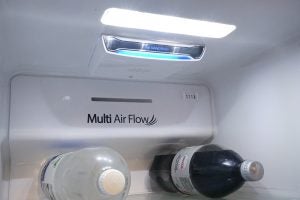
The top shelf was the warmest, averaging a nippy 2ºC degrees, while the mid-shelf was closer to 1.5ºC. Both drawers were lower still. The lower drawer averaged a chilly 0.75ºC average, while the upper of the two drawers scored an average of less that 0.5ºC. Very little temperature fluctuation during the compressor cycle meant that the air temperature rarely dipped below freezing in these drawers – but those figures are still rather low.
While a consistent lower temperature won’t be an issue for food storage, it does bump up energy use. Average temperature from near zero to 2ºC are just a bit too chilly to be energy efficient. Buyers would be well advised to purchase a cheap fridge thermometer and adjust the thermostat to save a bit of energy.
Conversely, the freezer couldn’t have been more faithful to the thermostat’s set temperature of -18ºC. At an average of -17ºC on the top shelf and -19ºC in the bottom drawer, the Multi Air Flow cooling is certainly doing its job well in keeping temperatures consistent too.
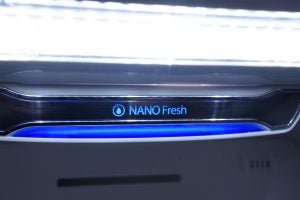
Our fresh-to-frozen food sample finally hit -18ºC at its core in a lengthy 28 hours. Since the freezer temperatures were faithful to the thermostat, a more realistic measure would be its time to -17ºC, which was a more reasonable 22 hours. Variation in temperature through the freezer compressor cycle was on par for a fridge freezer at this price. The bounce was around +/- 3ºC from the average temperatures, which is fine.
Likewise, the fail test results were okay, if not class-leading. The top shelf in the freezer crept up to -5ºC over three hours with no power. Our conservative food safety time – before the air temperature anywhere in the freezer exceeds zero – was a low-average of six hours. We can’t personally recall a power cut that long, so nothing to be too concerned about.
Aside from the fridge temperature being a good 2ºC lower than the set thermostat temperature, this Hisense turns in a very respectable technical performance for its price.
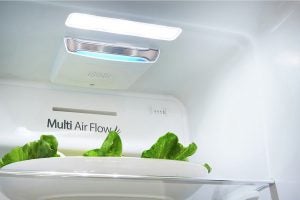
Hisense RS696N4II1 – How much will it cost to run?
Large-capacity US-style appliances are never the most frugal fridge freezers. Tall compartments accelerate temperature convection issues, particularly when you open the door and all the cold air simply rolls out. As such, we’ve never seen a US-style fridge freezer achieve more than an A++ rating; most are A+ or just A.
This Hisense falls right in the middle of that spectrum with a respectable A+ rating.
Over the course of a week’s testing, the RS696N4II1 used around 1.2kWh of electricity per day. That would equate to around 435kWh per annum. That’s remarkably close to the energy label’s claimed usage of 438kWh per year. At an average electricity price of 15p/kWh, you’re looking at annual electricity running costs of around £65.
Hot kitchens and busy families accessing the fridge and freezer more frequently will bump those costs up further. Yet, for its large-capacity cooling and even temperatures, the Hisense isn’t overly expensive to run.
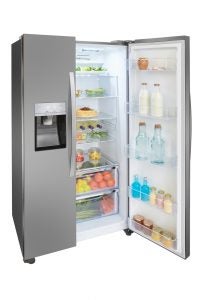
Why buy the Hisense RS696N4II1?
Once again, Hisense has impressed us with a combination of style, features and solid performance at a remarkably affordable price. Our sample’s fridge temperature came in a little low compared to thermostat settings and the fail-test was only average. Yet the RS696N4II1’s general cooling abilities are very consistent and energy consumption fair for its generous capacity. Fixtures and fittings are well made and the furniture layout is good, save for the lack of shelf height adjustment.
We (okay, I) love the big freezer door pockets too. Factor in the RS696N4II1’s plumbed ice and water dispenser and this Hisense brings you luxury US-style cooling at a less than luxury cost.
Verdict
Great value US-style fridge freezer, offering solid performance and build-quality that belies its relatively affordable price.
Trusted Score
Key Features
| Dimensions HxWxD (cm) | 179 x 91 x 74 |
| Energy Rating | A+ |
| Freezer Capacity | 168litres |
| Fridge Capacity | 367litres |
Test Results
| Approx. Annual Power Consumption (KWh) | 435kWh |
| Approx. Annual Running Cost | £65 |
| Running Noise (A weighted) | 40dB |
| Max. freezer air temp. after 3-hour fail (Celsius) | -5 degrees C |
| Max. freezer food temp. after 3-hour fail (Celsius) | -9 degrees C |
| Frozen safety limit (food to zero degrees) | 10 hours |
| Recovery time to -20 after 3-hour fail | 40mins |
| Average freezer temp. variation | +/- 1 degree |
| Average fridge temp. variation | +/- 3 degrees |


